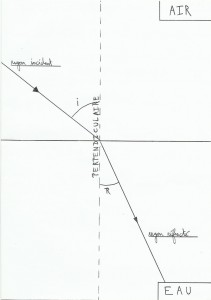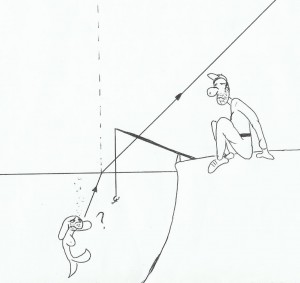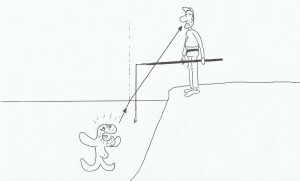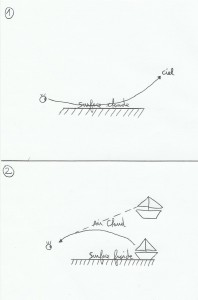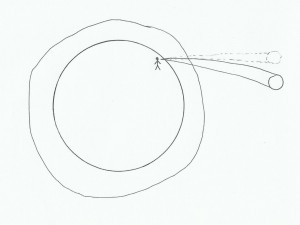This is a very simple rule discovered mainly by Snell, a dutch scientist. It focuses on the refraction of light in different materials. This rule is very important because it explains the mirages, why a submerged object deforms, why fishermen are sitting near the edge when fishing instead of standing and some corrections to be made between the true height and instrumental height(see “the meridian”). It also explains how to have a successful mayonnaise and winning the lottery(no, Just kidding not my best joke I guess…).
1)Main idea
The light propagates in vacuum space at the rate of about 300000 km/second, but when it crosses a denser material(for example from vacuum to air, air to water or a hot air to cold air which is denser)it slows, This also has the consequence to deflect lightrays. Main things, a ray which crosses a denser material where it slows approaches the perpendicular line to the boundary between the two materials. Light differs in reverse sens. The more difference in density between materials is strong the more ray is deflected.
We can put it all in that form, N1*sin(i)=N2*sin(r).
N1 is the air refractive index and N2 is for water. This is a number useful to evaluate the capacity of the material to deflect light, the higher the index is, the higher the light is deflected(the strongest index is found with diamond: 2,42, there is no unity). This index is the ratio between the speed of light in the environment concerned and in a vacuum space, vacuum thus has an index equal to one, a material with an index of two slows the speed of light by two(diamond thus slows the light almost 2,5 times higher than in the vacuum).
(Notice: Tools such as refractometers use this rule to measure concentration in a product, for example.)
2)Applications
One of the most significant examples is the fisherman and the fish. Due to the deflection of light, they don't see the same things, in fact not on the same angle…
Here, flipère the trout do not see Mr Igloo…
Damned! Flipère has guessed the trap!(excuse me it's late…).
The refractive index of air change with temperature, so rays are deflected and the object seen appears to come from elsewhere, this is the mirage:
Case 1 is easily noticeable in summer on paved roads thus more gifted to keep heat, it's like to see the waves on the horizon; in fact it is the sky that we see. If the temperature changes quickly depending on the height above sea, the rays from the bottom of the object will be more deflected than the top, the object may seem reversed.
Another notable effect, light perceived by the sun. The sun appears higher in the sky than it really is and flatter in its height. The first cause is the refractive index which varies in different layers of the atmosphere(further down in altitude, more the index increases as the air density increases)and the second reason is the lower edge of the sun appears more pointed than the top(always with the history of index changing).
This phenomenon is taken into account in celestial navigation, to determine the true height of the sun from the instrumental height, and also when we use star to find our position; it's better to choose the highest stars in the sky(so light sent less undergoes deviation). This correction is grouped with three other angles corrections, we find the tables in the ephemeris(the other three corrections are depression of the horizon, parallax and semi-diameter of the sun).
